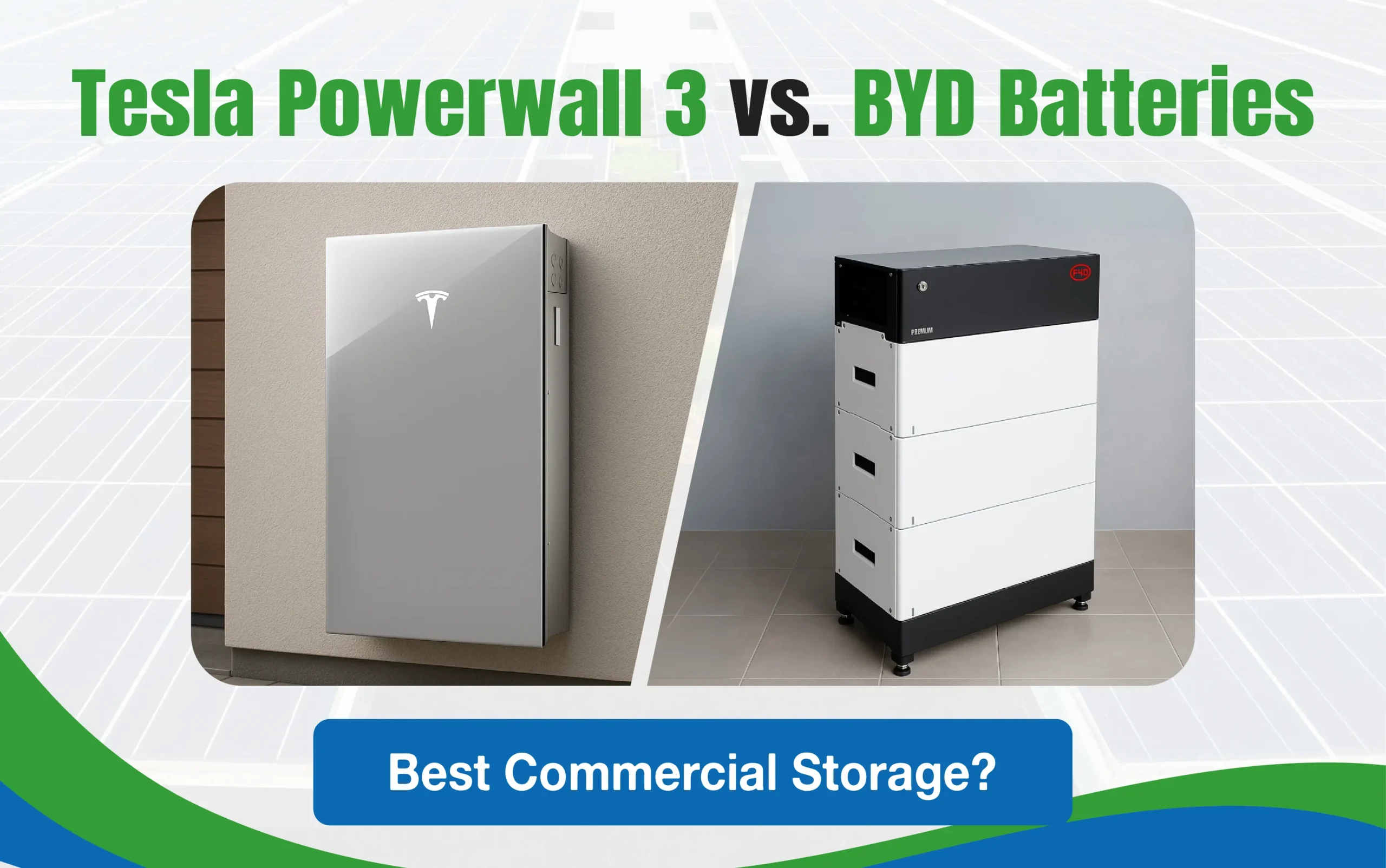If you are a business owner in Australia, you have probably felt the sting of rising electricity prices. Yes, solar panels are an excellent way to combat the issue of surging electricity prices and do good for the environment, but what happens when the sun goes down and you still have to draw power from the grid? The simple solution to this is installing a battery storage system for solar energy. However, with so many options out there, how do you know which one is right for you?
To clear things for you, today, we are pitting two of the biggest names in the game against each other: Tesla’s Powerwall 3 and the BYD Battery-Box. To help you understand the difference better, we will do an in-depth BYD vs Tesla battery comparison, so you can decide which one is the best fit for your venture’s bottom line and energy independence.
The Contenders: Tesla Powerwall 3 vs. BYD Batteries
You probably know Tesla for its electric cars, and of course, the sleek Powerwall. So, Powerwall 3 is the latest iteration of Tesla, and it is an all-in-one unit engineered to be a complete solar and storage solution. It has got a built-in solar inverter, which makes installation a breeze, especially for new solar setups, so when you go for Tesla Powerwall, we would say the integration is effortlessly seamless.
Then in line, we have BYD (Build Your Dreams), which is a global giant in the battery and electric vehicle space. Their battery-box series, especially the HVM and HVS models, is renowned for its modular design. Unlike the single-unit Powerwall, BYD’s system is like a set of building blocks. You start with a base unit and add more modules as your energy needs grow, and this makes it incredibly scalable and flexible.
Capacity, Chemistry, and Control: The Nitty-Gritty
When it comes to commercial applications, a few key factors matter the most:
- Capacity and Scalability: So, the Powerwall 3 has a fixed usable capacity of 13.5 kWh per unit. On the other hand, the BYD battery box is a champion of scalability, and a single tower can go from as little as 5.1 kWh up to 22.1 kWh, and with multiple towers, you can reach a massive 66.2 kWh or even higher with other models, and this is a massive advantage for a business that might want to grow its energy storage in stages.
- Battery Chemistry: Tesla’s Powerwall 2 uses Lithium Iron Phosphate (LFP) cells, which is a huge change from the older Powerwall 2’s Nickel Manganese Cobalt (NMC) chemistry. This shift is a massive game-changer because LFP is known for being safer and having a longer cycle life. On the other hand, BYD has been a revered name in the LFP chemistry for years. So, on the matters of safety and longevity, both are now on a more level playing field. However, in the Australian market, there’s a growing preference for LFP batteries due to their thermal stability and safety, which is a huge plus in our harsh climate.
- Integrated vs. Modular: The Powerwall 3’s built-in solar inverter is a standout feature, as it simplifies the installation process and can be a significant cost-saver, especially if you are installing a brand new solar system. However, the BYD battery box requires a compatible external inverter. While this might seem like a drawback, it actually gives you more flexibility to choose from a wide range of inverters that are already on the market from brands like Fronius, Sungrow, and GoodWe.
Cost and Return on Investment
When we are talking about BYD vs Tesla battery comparison, let’s also discuss dollars and cents because that’s what truly matters for a business. While the upfront costs can vary, the cost per usable kWh is a key metric to consider. The price generally fluctuates, but knowing the cost and ROI gives you a sense of the potential cost efficiency.
Here’s a quick comparison table to help you visualise the differences:
| Feature | Tesla Powerwall 3 | BYD Battery Box (HVS/HVM) |
|---|---|---|
| Chemistry | Lithium Iron Phosphate (LFP) | Lithium Iron Phosphate (LFP) |
| Max Capacity | Up to 54 kWh (4 units) | Up to 66.2 kWh (multiple towers) |
| Inverter | Built-in | Requires external inverter |
| Design | All-in-one unit | Modular and scalable |
Practical Tips for Decision-Making
- Ask installers for a full system quote (hardware + inverter + installation + commissioning + any gateway/controls).
- Model the levelized cost of stored energy (LCOSE) for your site: use realistic cycling assumptions (how many cycles/day), tariff structure, and the efficiency numbers.
- Check compatibility with your inverter and any backup/load-shedding strategy.
The Verdict
If your commercial site needs highly modular, high-efficiency, and large capacity storage that you can scale over time, BYD’s Battery-Box family is often the practical choice. On the other hand, if you prioritise integrated simplicity, high peak power per unit, and Tesla’s app + ecosystem, Powerwall 3 is a strong contender.
In case you are still stuck in the BYD vs Tesla battery comparison, let us tell you that for many Australian businesses, the right answers can also be a hybrid approach. Want help modelling payback for your specific site (load profile, tariffs, and solar size) or looking for the right solar battery storage systems? Reach out to our team at EcoGreen Australia today!

